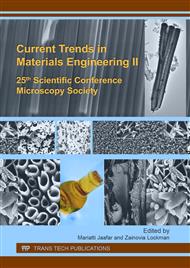[1]
P. L. Teh, M. Jaafar, H. M. Akil, K. N. Seetharamu, A. N. R. Wagiman, K. S. Beh, Thermal and mechanical properties of particulate fillers filled epoxy composites for electronic packaging application, Polymers for Advanced Technologies. 19(4) (2008).
DOI: 10.1002/pat.1014
Google Scholar
[2]
S. Singh, D. Gupta, V. Jain, A.K. Sharma, Microwave Processing of Materials and Applications in Manufacturing Industries: A Review, Materials and Manufacturing Processes. 30(1) (2015) 1-29.
DOI: 10.1080/10426914.2014.952028
Google Scholar
[3]
J. Friedrich, Bulk, Ablative, and Side Reactions, The Plasma Chemistry of Polymer Surfaces, Wiley-VCH Verlag GmbH & Co., 2012, pp.145-195.
Google Scholar
[4]
S. Bhattacharya, R.K. Singh, S. Mandal, A. Ghosh, S. Bok, V. Korampally, K. Gangopadhyay, S. Gangopadhyay, Plasma Modification of Polymer Surfaces and Their Utility in Building Biomedical Microdevices, Journal of Adhesion Science and Technology. 24(15-16) (2010).
DOI: 10.1163/016942410x511105
Google Scholar
[5]
J. Friedrich, R. Mix, G. Hidde, Ways to Generate Monosort Functionalized Polyolefin Surfaces, K.L. Mittal (Eds. ), in: Progress in Adhesion and Adhesives, John Wiley & Sons Inc., 2015, pp.299-355.
DOI: 10.1002/9781119162346.ch9
Google Scholar
[6]
F. Garbassi, M. Morra, E. Occhiello, Wettability, in: Polymer Surfaces: from Physics to Technology, John Wiley & Sons Ltd., 1994, pp.301-331.
DOI: 10.1177/004051759406401110
Google Scholar
[7]
T. Uelzen, J. Müller, Wettability enhancement by rough surfaces generated by thin film technology, Thin Solid Films. 434(1–2) (2003) 311-315.
DOI: 10.1016/s0040-6090(03)00484-x
Google Scholar
[8]
S. Große-Kreul, C. Corbella, A. von Keudell, Chemical and Physical Sputtering of Polyethylene Terephthalate (PET), Plasma Processes and Polymers. 10(3) (2013) 225-234.
DOI: 10.1002/ppap.201200094
Google Scholar
[9]
H.Y. Peng, M. Devarajan, T.T. Lee, Comparison of Argon and Oxygen Plasma Treatments on LED Chip Bond Pad for Wire Bond Application, International Journal of Scientific & Engineering Research. 5(12) (2014) 908-912.
DOI: 10.1108/ssmt-03-2015-0006
Google Scholar
[10]
A. J. Stoltz. Dry Plasma Processing of Mercury Cadmium Telluride and Related II–VIs. P. Capper, and J. W. Garland, (Eds. ), in: Mercury Cadmium Telluride: John Wiley & Sons Ltd., 2010, pp.399-427.
DOI: 10.1002/9780470669464.ch17
Google Scholar
[11]
P. Eaton, Atomic Force Microscopy–AFM, Kirk-Othmer Encyclopedia of Chemical Technology, John Wiley & Sons Inc., (2000).
DOI: 10.1002/0471238961.0120151319011809.a01.pub2
Google Scholar
[12]
D. Li, A.W. Neumann, Contact angles on hydrophobic solid surfaces and their interpretation, Journal of Colloid and Interface Science. 148(1) (1992) 190-200.
DOI: 10.1016/0021-9797(92)90127-8
Google Scholar
[13]
B. C. Smith. Infrared Spectral Interpretation: A Systematic Approach: CRC Press, (1998).
Google Scholar


